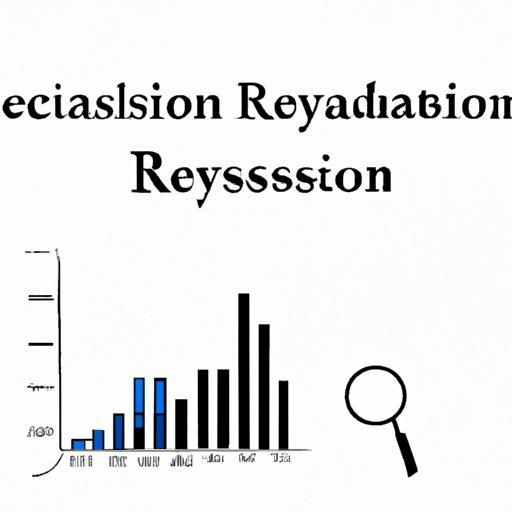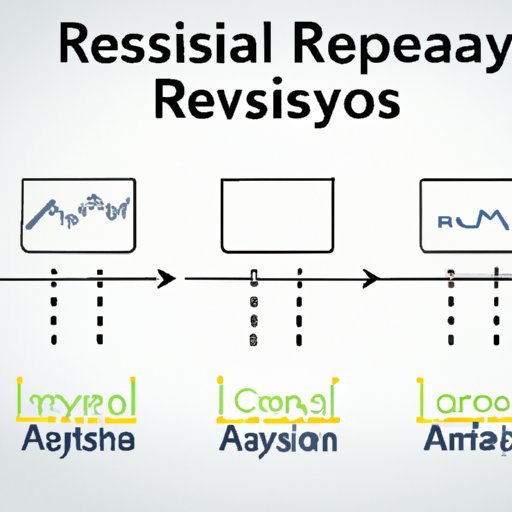I. Introduction
Regression Analysis is a statistical method used to examine the relationship between one dependent variable and one or more independent variables. It is used to fit a model that best describes the relationship between the variables, making it a useful tool in research and data analytics. Regression Analysis is an essential technique used in different fields, including finance, economics, biology, engineering, and many others. This article provides a comprehensive guide to Regression Analysis, its importance, types, practical application, advantages, and disadvantages.

II. An Introduction to Regression Analysis: Understanding the Basics
Regression Analysis is a statistical technique used to model the relationship between a dependent variable and one or more independent variables. The dependent variable is the output or response variable, while the independent variable is the input or predictor variable. Regression Analysis is based on the assumption that there is a linear relationship between the dependent and independent variables. There are two types of Regression Analysis, Simple and Multiple Regression Analysis.
Simple Regression Analysis involves modeling the relationship between two variables, with one variable as the dependent variable and the other as the independent variable. Multiple Regression Analysis involves modeling the relationship between a dependent variable and two or more independent variables.
III. Everything You Need to Know About Regression Analysis: The Ultimate Guide
The process of Regression Analysis involves several steps, including selecting variables, data collection, fitting the model, evaluating the model, and testing for statistical significance. There are different types of Regression Models, including Linear, Polynomial, Logistic, and Ridge Regression.
Linear Regression is the most common type of Regression Analysis and involves modeling a linear relationship between the dependent and independent variables. Polynomial Regression is an extension of Linear Regression, used to model nonlinear relationships between variables. Logistic Regression, on the other hand, is used to model the probability of an event occurring based on a set of independent variables. Ridge Regression is used when multicollinearity is present in the independent variables.
Regression Analysis has several advantages, including its ability to identify the strength and significance of relationships between variables, making it a useful tool in predictive modeling. However, it also has some drawbacks, such as the assumptions needed to perform it and its vulnerability to outliers.
IV. Unlocking the Mysteries of Regression Analysis: A Comprehensive Overview
Before performing Regression Analysis, certain assumptions must hold. These assumptions include the linear relationship between the dependent and independent variables, independence of errors, homoscedasticity, normality of errors, and absence of multicollinearity.
Testing and analyzing Regression Analysis results involves examining the estimated slope, intercept, residuals, and R-squared statistic. The slope represents the strength and direction of the relationship between the variables, while the R-squared statistic shows how well the regression line fits the data.
Guidelines for interpreting Regression Analysis output include looking at the p-values, confidence intervals, and coefficient values. The p-value indicates whether the relationship between the independent and dependent variables is statistically significant, while the confidence interval provides an estimate of the range of values that the coefficient of the variable might take. The coefficient value indicates the direction and strength of the relationship between the independent and dependent variables.
V. Regression Analysis: A Powerful Tool for Predictive Modeling
Regression Analysis is one of the most important techniques used in predictive modeling. It is used to build models that help to predict future outcomes based on historical data. Regression Analysis is used in different industries, including healthcare, banking, finance, advertising, and many others. It helps to identify the different factors that impact outcomes, making it possible to adjust for these factors and improve results.
The advantages of using Regression Analysis in predictive modeling include its ability to identify relevant predictors, its flexibility in handling different types of data, and its ability to show statistical significance. Regression Analysis is also easy to understand and implement, making it accessible to a wide range of users.
Examples of industries using Regression Analysis for predictive modeling include hospitals, where it is used to predict patient outcomes and optimize treatment plans, and the financial services industry, where it is used to predict stock prices and evaluate credit risk.
VI. Understanding How Regression Analysis Works and Its Practical Applications
Regression Analysis is used in different real-life scenarios, including scientific research, business analytics, and financial modeling. It is used to gain insights from data by identifying the relationship between variables. Regression Analysis works by fitting a model that best describes the relationship between the dependent and independent variables, providing information on the strength and direction of that relationship.
Practical applications of Regression Analysis in research and data analysis include predicting customer behavior, forecasting sales figures, identifying market trends, and modeling employee performance. Regression Analysis helps to identify factors that impact an outcome, making it possible to adjust for these factors and improve results.
VII. The Importance of Regression Analysis: How to Use It to Gain Insights from Your Data
Regression Analysis is a powerful tool for gaining insights from data. To use it, it is important to select appropriate variables that are relevant to the analysis. This involves understanding the context of the data, the purpose of the analysis, and the questions being asked.
One of the most important things to keep in mind when using Regression Analysis is the need for careful interpretation of the results. This involves looking at the significance of the relationships between variables, evaluating the accuracy of the model, and checking for possible errors.
Regression Analysis is an essential tool for research and data analytics. It helps to identify the relationship between variables and to build predictive models that can guide decision-making across different industries.
VIII. Conclusion
This comprehensive guide to Regression Analysis has provided information on its definition, terminologies, types, advantages, and disadvantages. It has also explored the process of performing Regression Analysis, analyzing the results, and testing for statistical significance. Regression Analysis is a critical tool for predictive modeling and data analysis. Its practical applications in different industries, such as business, finance, and healthcare, make it an essential tool for gaining insights from data.
Regression Analysis has helped researchers and analysts predict future outcomes, evaluate the impact of different factors on outcomes, and optimize processes to achieve better results. Therefore, it is essential to understand the importance of Regression Analysis and its role in research and data analytics.
